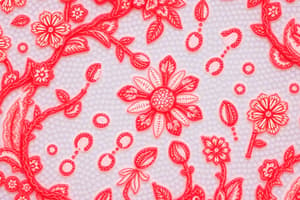Podcast
Questions and Answers
How are epithelial tissue cells arranged?
How are epithelial tissue cells arranged?
- Forming a discontinuous sheet
- Organized in a random pattern
- Loosely packed with large intercellular spaces
- Tightly packed with hardly any intercellular spaces (correct)
Which of the following is NOT made of epithelial tissue according to the text?
Which of the following is NOT made of epithelial tissue according to the text?
- Liver (correct)
- Kidney tubules
- Lining of blood vessels
- Skin
Why is the permeability of epithelial cells important?
Why is the permeability of epithelial cells important?
- To facilitate the movement of waste products
- To regulate body temperature
- To aid in digestion
- To regulate the exchange of materials between the body and external environment (correct)
How does epithelial tissue differ from connective tissue?
How does epithelial tissue differ from connective tissue?
Flashcards are hidden until you start studying
Study Notes
Arrangement of Epithelial Tissue Cells
- Epithelial cells are arranged in continuous sheets, forming either single layers (simple) or multiple layers (stratified).
- Cells are closely packed with minimal extracellular matrix, ensuring a barrier to protect underlying structures.
Epithelial Tissue Identification
- Epithelial tissue does not include connective tissues like bones, cartilage, and adipose tissue.
- Distinction is based on function and structure rather than location within the body.
Importance of Permeability in Epithelial Cells
- Permeability allows selective absorption and secretion, crucial for functions such as nutrient uptake and waste excretion.
- Regulates exchange of substances, protecting underlying tissues while maintaining necessary homeostasis.
Differences from Connective Tissue
- Epithelial tissue has no blood vessels and relies on adjacent connective tissue for nourishment and waste removal.
- Connective tissue is characterized by a significant amount of extracellular matrix, unlike the tightly packed arrangement of epithelial cells.
- Epithelial tissue primarily covers surfaces and forms barriers, whereas connective tissue supports and binds other tissues and organs.
Studying That Suits You
Use AI to generate personalized quizzes and flashcards to suit your learning preferences.




